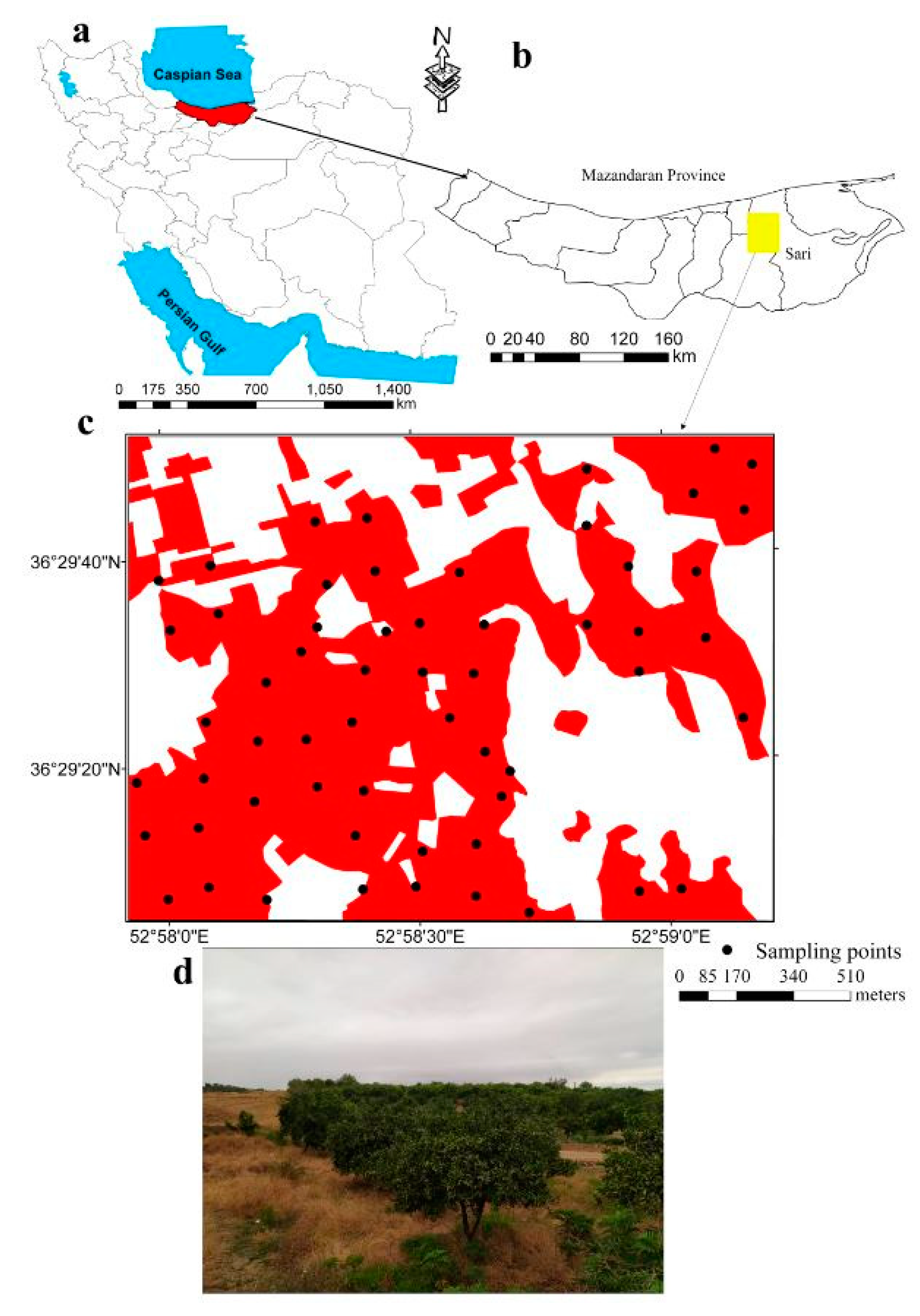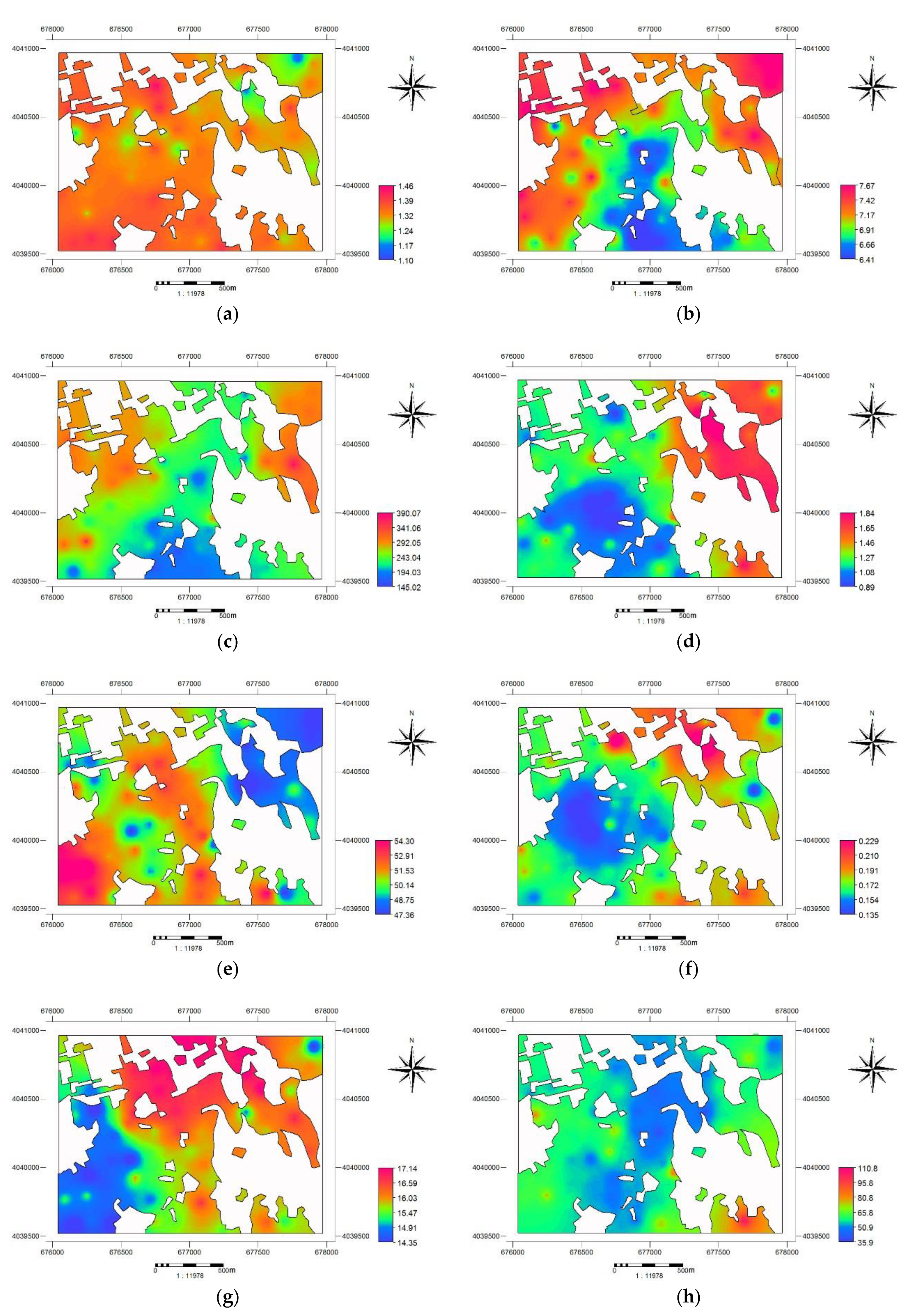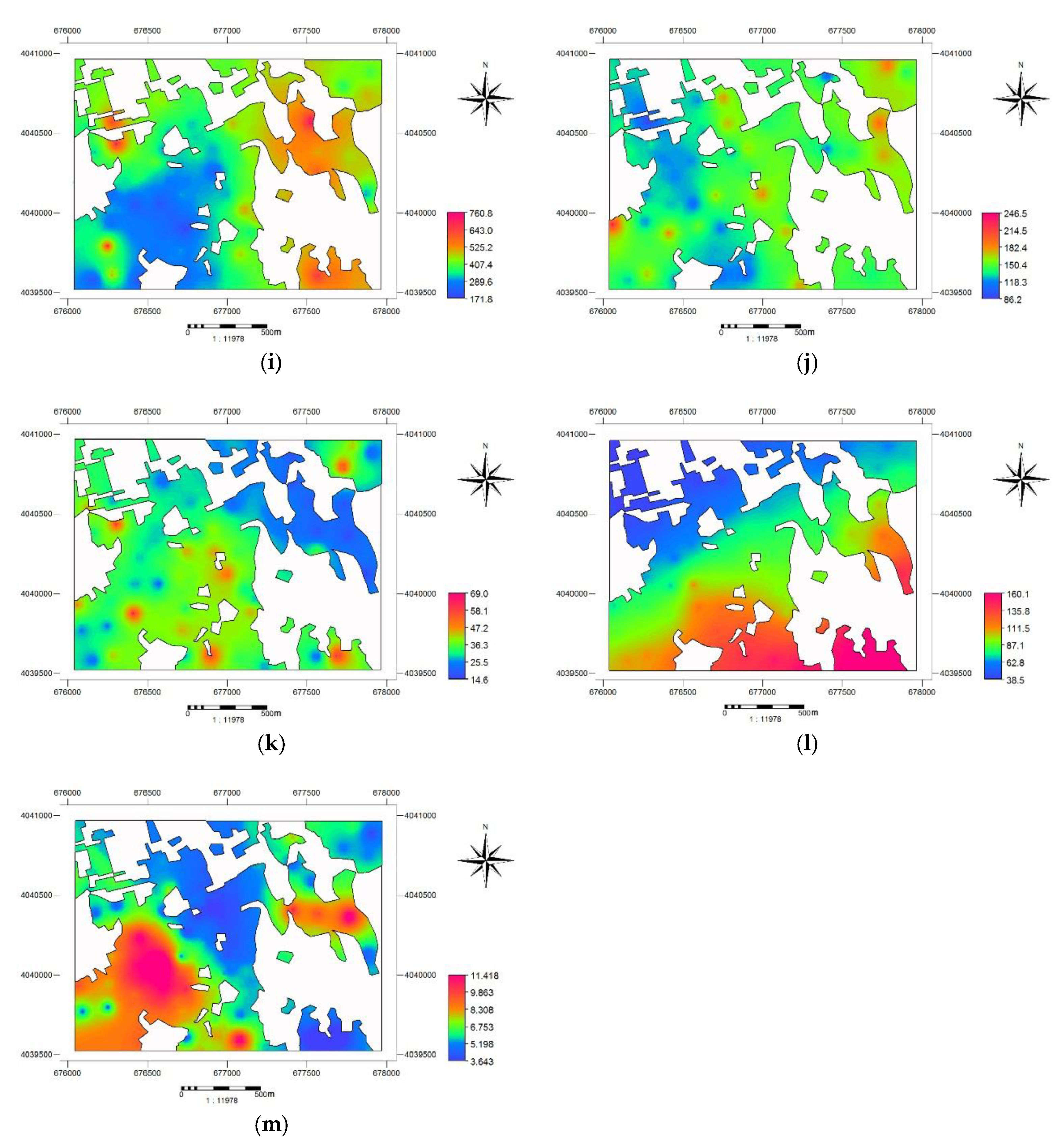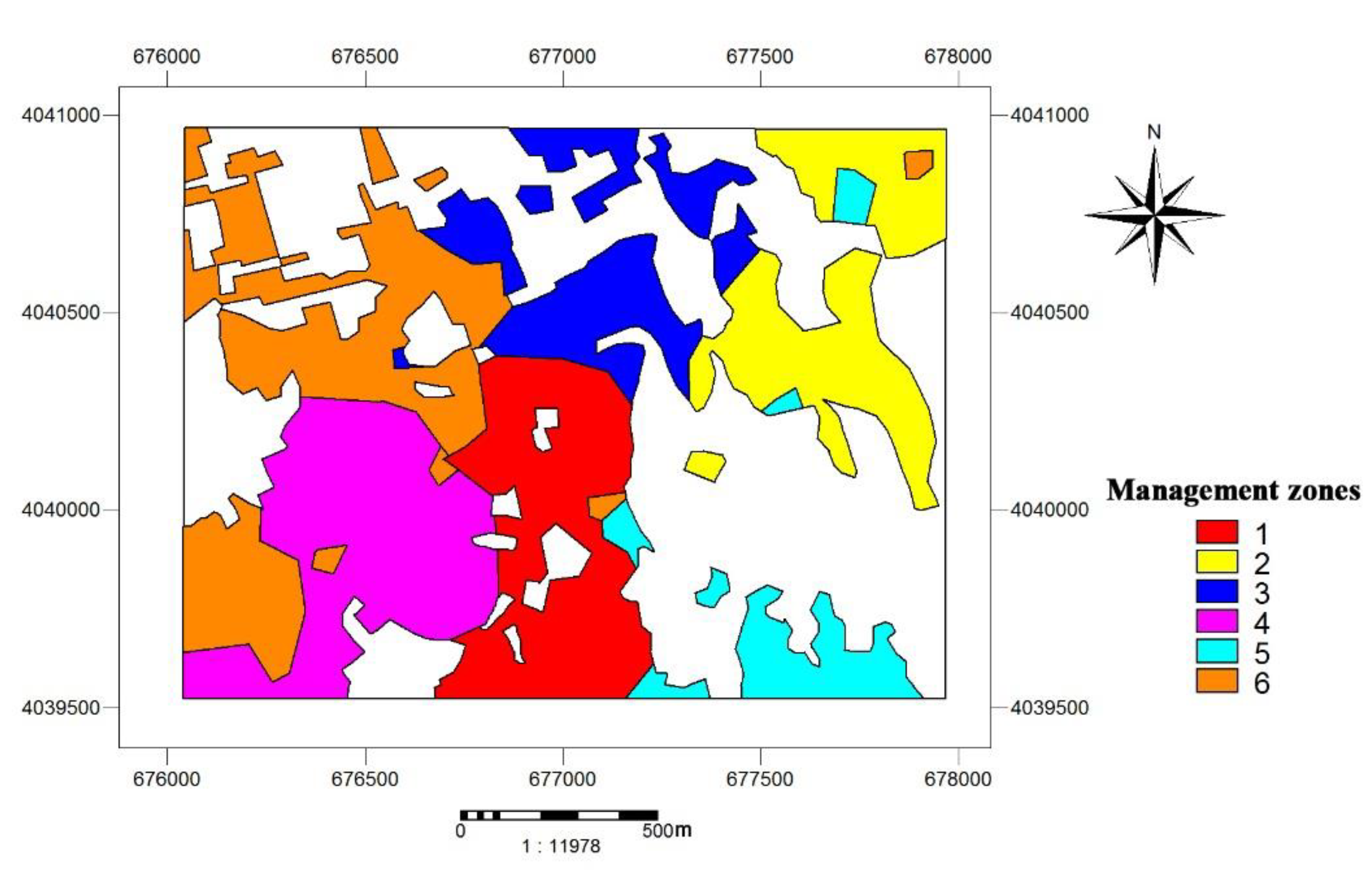Integration of PCA and Fuzzy Clustering for Delineation of Soil Management Zones and Cost-Efficiency Analysis in a Citrus Plantation
Abstract
:1. Introduction
2. Materials and Methods
2.1. Study Area
2.2. Field Sampling and Data Collection
2.3. Soil Physicochemical Properties Analysis
2.4. Statistical Analysis
2.4.1. Descriptive Statistics Analysis
2.4.2. Spatial Variability Analysis
2.4.3. Delineation of Management Zone
2.4.4. Economic Analysis
3. Results and Discussion
3.1. Exploratory Data Analysis
3.2. Spatial Variability Analysis
3.3. Principal Component Analysis (PCA)
3.4. Clustering Analysis
3.5. Economic Analysis of Delineated Zones
4. Conclusions
Author Contributions
Funding
Conflicts of Interest
References
- Ladanyia, M.; Ladaniya, M. Citrus Fruit: Biology, Technology and Evaluation; Academic Press: Cambridge, MA, USA, 2010. [Google Scholar]
- Goldschmidt, E.E.; Koch, K.E. Citrus. In Photoassimilate Distribution Plants and Crops Source-Sink Relationships; Routledge: Abingdon, UK, 2017; pp. 797–824. [Google Scholar]
- Liu, Y.; Heying, E.; Tanumihardjo, S.A. History, global distribution, and nutritional importance of citrus fruits. Compr. Rev. Food Sci. Food Saf. 2012, 11, 530–545. [Google Scholar] [CrossRef]
- FAO. Citrus Fruit-Fresh and Processed Statistical Bulletin 2016; Food and Agriculture Organization of the United Nations: Rome, Italy, 2017; p. 66. [Google Scholar]
- Tripathi, R.; Nayak, A.; Shahid, M.; Lal, B.; Gautam, P.; Raja, R.; Mohanty, S.; Kumar, A.; Panda, B.; Sahoo, R. Delineation of soil management zones for a rice cultivated area in eastern India using fuzzy clustering. Catena 2015, 133, 128–136. [Google Scholar] [CrossRef]
- Wan, S.; Zhang, C.; Chen, Y.; Zhao, J.; Zhu, X.; Wu, J.; Zhou, L.; Lin, Y.; Liu, Z.; Fu, S. Interactive effects of understory removal and fertilization on soil respiration in subtropical Eucalyptus plantations. J. Plant Ecol. 2015, 8, 284–290. [Google Scholar] [CrossRef] [Green Version]
- Dobermann, A.; Oberthür, T. Fuzzy mapping of soil fertility—A case study on irrigated riceland in the Philippines. Geoderma 1997, 77, 317–339. [Google Scholar] [CrossRef]
- Castrignanò, A.; Buttafuoco, G.; Quarto, R.; Parisi, D.; Rossel, R.V.; Terribile, F.; Langella, G.; Venezia, A. A geostatistical sensor data fusion approach for delineating homogeneous management zones in Precision Agriculture. Catena 2018, 167, 293–304. [Google Scholar] [CrossRef]
- Oldoni, H.; Terra, V.S.S.; Timm, L.C.; Júnior, C.R.; Monteiro, A.B. Delineation of management zones in a peach orchard using multivariate and geostatistical analyses. Soil Tillage Res. 2019, 191, 1–10. [Google Scholar] [CrossRef]
- Chang, D.; Zhang, J.; Zhu, L.; Ge, S.-H.; Li, P.-Y.; Liu, G.-S. Delineation of management zones using an active canopy sensor for a tobacco field. Comput. Electron. Agric. 2014, 109, 172–178. [Google Scholar] [CrossRef]
- Gili, A.; Álvarez, C.; Bagnato, R.; Noellemeyer, E. Comparison of three methods for delineating management zones for site-specific crop management. Comput. Electron. Agric. 2017, 139, 213–223. [Google Scholar] [CrossRef]
- Metwally, M.S.; Shaddad, S.M.; Liu, M.; Yao, R.-J.; Abdo, A.I.; Li, P.; Jiao, J.; Chen, X. Soil Properties Spatial Variability and Delineation of Site-Specific Management Zones Based on Soil Fertility Using Fuzzy Clustering in a Hilly Field in Jianyang, Sichuan, China. Sustainability 2019, 11, 7084. [Google Scholar] [CrossRef] [Green Version]
- Ortega, R.A.; Santibáñez, O.A. Determination of management zones in corn (Zea mays L.) based on soil fertility. Comput. Electron. Agric. 2007, 58, 49–59. [Google Scholar] [CrossRef]
- Xin-Zhong, W.; Guo-Shun, L.; Hong-Chao, H.; Zhen-Hai, W.; Qing-Hua, L.; Xu-Feng, L.; Wei-Hong, H.; Yan-Tao, L. Determination of management zones for a tobacco field based on soil fertility. Comput. Electron. Agric. 2009, 65, 168–175. [Google Scholar] [CrossRef]
- Davatgar, N.; Neishabouri, M.; Sepaskhah, A. Delineation of site specific nutrient management zones for a paddy cultivated area based on soil fertility using fuzzy clustering. Geoderma 2012, 173, 111–118. [Google Scholar] [CrossRef]
- Jiang, H.-L.; Liu, G.-S.; Liu, S.-D.; Li, E.-H.; Wang, R.; Yang, Y.-F.; Hu, H.-C. Delineation of site-specific management zones based on soil properties for a hillside field in central China. Arch. Agron. Soil Sci. 2012, 58, 1075–1090. [Google Scholar] [CrossRef]
- Schenatto, K.; de Souza, E.G.; Bazzi, C.L.; Gavioli, A.; Betzek, N.M.; Beneduzzi, H.M. Normalization of data for delineating management zones. Comput. Electron. Agric. 2017, 143, 238–248. [Google Scholar] [CrossRef]
- Keshavarzi, A.; Kumar, V.; Bottega, E.L.; Rodrigo-Comino, J. Determining land management zones using pedo-geomorphological factors in potential degraded regions to achieve land degradation neutrality. Land 2019, 8, 92. [Google Scholar] [CrossRef] [Green Version]
- Fu, Q.; Wang, Z.; Jiang, Q. Delineating soil nutrient management zones based on fuzzy clustering optimized by PSO. Math. Comput. Model. 2010, 51, 1299–1305. [Google Scholar] [CrossRef]
- Jiang, H.-L.; Liu, G.-S.; Wang, R.; Liu, S.-D.; Han, F.-G.; Yang, Y.-F.; Ye, X.-F.; Zhang, Q.-J.; Wang, X.-J.; Wang, Z.-H. Delineating site-specific quality-based management zones for a tobacco field. Soil Sci. 2011, 176, 206–212. [Google Scholar] [CrossRef]
- Zhao, C.; Fu, S.; Mathew, R.P.; Lawrence, K.S.; Feng, Y. Soil microbial community structure and activity in a 100-year-old fertilization and crop rotation experiment. J. Plant Ecol. 2015, 8, 623–632. [Google Scholar] [CrossRef] [Green Version]
- McKinion, J.; Jenkins, J.; Akins, D.; Turner, S.; Willers, J.L.; Jallas, E.; Whisler, F. Analysis of a precision agriculture approach to cotton production. Comput. Electron. Agric. 2001, 32, 213–228. [Google Scholar] [CrossRef]
- Hedley, C. The role of precision agriculture for improved nutrient management on farms. J. Sci. Food Agric. 2015, 95, 12–19. [Google Scholar] [CrossRef]
- Aggelopooulou, K.; Castrignanò, A.; Gemtos, T.; De Benedetto, D. Delineation of management zones in an apple orchard in Greece using a multivariate approach. Comput. Electron. Agric. 2013, 90, 119–130. [Google Scholar] [CrossRef]
- Valente, D.S.M.; Queiroz, D.M.D.; Pinto, F.D.A.D.C.; Santos, N.T.; Santos, F.L. Definition of management zones in coffee production fields based on apparent soil electrical conductivity. Sci. Agric. 2012, 69, 173–179. [Google Scholar] [CrossRef] [Green Version]
- Peralta, N.R.; Costa, J.L.; Balzarini, M.; Franco, M.C.; Córdoba, M.; Bullock, D. Delineation of management zones to improve nitrogen management of wheat. Comput. Electron. Agric. 2015, 110, 103–113. [Google Scholar] [CrossRef]
- Kangarshahi, A.A.; Akhlaghi Amiri, N. Advanced and Applied Citrus Nutrition; Agricultural Education and Promotion Publications: Tehran, Iran, 2015; Volume I, p. 312. [Google Scholar]
- Soil Survey Staff. Keys to Soil Taxonomy, 12th ed.; USDA-Natural Resources Conservation Service: Washington, DC, USA, 2014.
- Mallarino, A. Management Zones Soil Sampling: A Better Alternative to Grid and Soil Type Sampling? Iowa State University Digital Press: Ames, IA, USA, 2001. [Google Scholar]
- Nelson, D.W.; Sommers, L.E. Total carbon, organic carbon, and organic matter. Methods Soil Anal. Part 3 Chem. Methods 1996, 5, 961–1010. [Google Scholar]
- Blake, G.R.; Hartge, K.H. Bulk density. In Methods of Soil Analysis. Part 1. Physical and Mineralogical Methods, 2nd ed.; Klute, A., Ed.; ASA; SSSA: Madison, WI, USA, 1986; pp. 363–382. [Google Scholar]
- McLean, E.; Mulvaney, C. Soil pH and lime requirement. In Methods of Soil Analysis. Part 2. Chemical and Microbiological Properties; Wiley Online Library: Hoboken, NJ, USA, 1982. [Google Scholar]
- Rhoades, J. Soluble salts. In Methods of Soil Analysis Part 2: Chemical and Microbiological Properties; Page, A.L., Miller, R.H., Keeney, D.R., Eds.; American Society of Agronomy: Madison, WI, USA, 1982; pp. 167–178. [Google Scholar]
- Bremner, J. Nitrogen–total. In Methods of Soil Analyses, Part 3, Chemical Methods; Sparks, D.L., Ed.; Soil Science Society of America and American Society of Agronomy: Madison, WI, USA, 1996; pp. 1085–1122. [Google Scholar]
- Estefan, G.; Sommer, R.; Ryan, J. Methods of soil, plant, and water analysis. In A Manual for the West Asia and North Africa Region; ICARDA: Beirut, Lebanon, 2013; Volume 3. [Google Scholar]
- Olsen, S.R. Estimation of Available Phosphorus in Soils by Extraction with Sodium Bicarbonate; US Department of Agriculture: Washington, DC, USA, 1954.
- Mc Lean, E.; Watson, M. Soil measurements of plant-available potassium. In Potassium in Agriculture; Wiley Online Library: Hoboken, NJ, USA, 1985; pp. 277–308. [Google Scholar]
- Bakhshandeh, E.; Francaviglia, R.; Renzi, G. A cost and time-effective method to evaluate soil microbial respiration for soil quality assessment. Appl. Soil Ecol. 2019, 140, 121–125. [Google Scholar] [CrossRef]
- Vance, E.D.; Brookes, P.C.; Jenkinson, D.S. An extraction method for measuring soil microbial biomass C. Soil Biol. Biochem. 1987, 19, 703–707. [Google Scholar] [CrossRef]
- Institute, S. Base SAS 9.4 Procedures Guide; SAS Institute: Cary, NC, USA, 2015. [Google Scholar]
- Warrick, A.W.; Nielsen, D.R. Spatial variability of soil physical properties the soil. In Applications of Soil Physics; Hill, D., Ed.; Academic Press: New York, NY, USA, 1980; pp. 319–344. [Google Scholar]
- Behera, S.K.; Mathur, R.K.; Shukla, A.K.; Suresh, K.; Prakash, C. Spatial variability of soil properties and delineation of soil management zones of oil palm plantations grown in a hot and humid tropical region of southern India. Catena 2018, 165, 251–259. [Google Scholar] [CrossRef]
- Rodrigo-Comino, J.; Keshavarzi, A.; Zeraatpisheh, M.; Gyasi-Agyei, Y.; Cerdà, A. Determining the best ISUM (Improved stock unearthing Method) sampling point number to model long-term soil transport and micro-topographical changes in vineyards. Comput. Electron. Agric. 2019, 159, 147–156. [Google Scholar] [CrossRef]
- Zeraatpisheh, M.; Ayoubi, S.; Sulieman, M.; Rodrigo-Comino, J. Determining the spatial distribution of soil properties using the environmental covariates and multivariate statistical analysis: A case study in semi-arid regions of Iran. J. Arid Land 2019, 11, 551–566. [Google Scholar] [CrossRef] [Green Version]
- Jamieson, P.; Porter, J.; Wilson, D. A test of the computer simulation model ARCWHEAT1 on wheat crops grown in New Zealand. Field Crops Res. 1991, 27, 337–350. [Google Scholar] [CrossRef]
- Fridgen, J.J.; Kitchen, N.R.; Sudduth, K.A.; Drummond, S.T.; Wiebold, W.J.; Fraisse, C.W. Management zone analyst (MZA). Agron. J. 2004, 96, 100–108. [Google Scholar] [CrossRef]
- Odeh, I.; McBratney, A.; Chittleborough, D. Soil pattern recognition with fuzzy-c-means: Application to classification and soil-landform interrelationships. Soil Sci. Soc. Am. J. 1992, 56, 505–516. [Google Scholar] [CrossRef]
- Soil and Water Research Institute of Iran. 2019. Available online: http://www.swri.ir/ (accessed on 1 October 2019).
- Hosseini, M.; Movahedi Naeini, S.A.R.; Dehghani, A.A.; Zeraatpisheh, M. Modeling of soil mechanical resistance using intelligent methods. J. Soil Sci. Plant Nutr. 2018, 18, 939–951. [Google Scholar] [CrossRef] [Green Version]
- Sumner, M.E. Handbook of Soil Science; CRC Press: Boca Raton, FL, USA, 1999. [Google Scholar]
- Wilding, L.P.; Dress, L.R. Application of geostatistics to spatial studies of soil. In Advances in Agronomy; Trangmar, B.B., Yost, R.S., Uehara, G., Eds.; Academic Press, Inc.: Orlando, FL, USA, 1983; Volume 38. [Google Scholar]
- Karaman, M.; Ersahin, S.; Durak, A. Spatial variability of available phosphorus and site specific phosphorus fertilizer recommendations in a wheat field. In Plant Nutrition–Food Security and Sustainability of Agro-Ecosystems Through Basic and Applied Research; Horst, W.J., Ed.; Kluwer Academic Publishers: Dordrecht, The Netherlands, 2001. [Google Scholar]
- Bahmanyar, M.; Abtahi, A.; Banaee, M. Soil landscape relationshipps between different physiographic units in tejan catchment (northern iran). Iran Agric. Res. 1999, 18, 107–124. [Google Scholar]
- Yao, R.-J.; Yang, J.-S.; Zhang, T.-J.; Gao, P.; Wang, X.-P.; Hong, L.-Z.; Wang, M.-W. Determination of site-specific management zones using soil physico-chemical properties and crop yields in coastal reclaimed farmland. Geoderma 2014, 232, 381–393. [Google Scholar] [CrossRef]
- Metternicht, G.; Zinck, J. Remote sensing of soil salinity: Potentials and constraints. Remote Sens. Environ. 2003, 85, 1–20. [Google Scholar] [CrossRef]
- Hosseini, M.; Naeini, S.A.M.; Dehghani, A.A.; Khaledian, Y. Estimation of soil mechanical resistance parameter by using particle swarm optimization, genetic algorithm and multiple regression methods. Soil Tillage Res. 2016, 157, 32–42. [Google Scholar] [CrossRef]
- Bullock, D.S.; Ruffo, M.L.; Bullock, D.G.; Bollero, G.A. The value of variable rate technology: An information-theoretic approach. Am. J. Agric. Econ. 2009, 91, 209–223. [Google Scholar] [CrossRef]
- Gavioli, A.; de Souza, E.G.; Bazzi, C.L.; Schenatto, K.; Betzek, N.M. Identification of management zones in precision agriculture: An evaluation of alternative cluster analysis methods. Biosyst. Eng. 2019, 181, 86–102. [Google Scholar] [CrossRef]
- Breunig, F.M.; Galvão, L.S.; Dalagnol, R.; Dauve, C.E.; Parraga, A.; Santi, A.L.; Della Flora, D.P.; Chen, S. Delineation of management zones in agricultural fields using cover–crop biomass estimates from PlanetScope data. Int. J. Appl. Earth Obs. Geoinf. 2020, 85, 102004. [Google Scholar] [CrossRef]





| Variable | Mean | Median | Minimum | Maximum | STD | CV | Skewness | Kurtosis | d | Optimum Level (Kangarshahi and Akhlaghi Amiri [27]) |
|---|---|---|---|---|---|---|---|---|---|---|
| BD | 1.33 | 1.36 | 0.99 | 1.55 | 0.12 | 8.92 | −0.78 | 0.46 | 0.113 N | 1.1–1.3 |
| pH | 7.11 | 7.24 | 5.11 | 8.35 | 0.81 | 11.35 | −0.42 | −0.61 | 0.097 N | 6–6.5 |
| EC | 251.37 | 244.00 | 94.50 | 442.00 | 87.43 | 34.78 | 0.08 | −0.73 | 0.077 N | <1700 |
| SOC | 1.30 | 1.28 | 0.35 | 3.05 | 0.50 | 38.73 | 0.70 | 1.54 | 0.082 N | ≥2 |
| Cl | 50.70 | 50.60 | 40.00 | 61.20 | 4.29 | 8.46 | −0.03 | −0.07 | 0.070 N | Sandy loam, loam, clay loam, silty clay loam |
| TN | 0.17 | 0.18 | 0.06 | 0.45 | 0.06 | 33.75 | 2.00 | 8.37 | 0.154 N | 0.2 |
| CEC | 15.71 | 15.68 | 11.90 | 18.79 | 1.61 | 10.26 | −0.30 | −0.32 | 0.074 N | 15 |
| Mres4 | 59.85 | 55.54 | 25.45 | 127.06 | 22.01 | 36.78 | 1.11 | 1.53 | 0.104 N | – |
| Cmic | 395.63 | 339.22 | 83.21 | 978.74 | 217.64 | 55.01 | 0.75 | 0.16 | 0.122 N | – |
| Kav | 144.87 | 144.00 | 49.87 | 277.76 | 49.38 | 34.08 | 0.42 | −0.39 | 0.081 N | 250 |
| Pav | 33.20 | 24.95 | 10.17 | 84.00 | 21.90 | 65.95 | 0.86 | −0.37 | 0.061 N | 20 |
| Elevation (m) | 90.40 | 87.00 | 38.00 | 162.00 | 34.26 | 37.90 | 0.44 | −0.71 | 0.101 N | No limitation—water table > 1.5 m |
| Slope (%) | 6.54 | 4.47 | 0.00 | 30.59 | 5.52 | 84.42 | 1.82 | 5.37 | 0.155 N | 0–2% |
| Variable | BD | pH | EC | SOC | Cl | TN | Kav | Mres4 | Cmic | CEC | Pav | Elevation (m) | Slope (%) |
|---|---|---|---|---|---|---|---|---|---|---|---|---|---|
| BD | 1 | ||||||||||||
| pH | −0.126 * | 1 | |||||||||||
| EC | −0.285 ** | 0.814 ** | 1 | ||||||||||
| SOC | −0.672 ** | 0.170 * | 0.327 ** | 1 | |||||||||
| Cl | 0.512 ** | −0.204 ** | −0.273 ** | −0.654 ** | 1 | ||||||||
| TN | −0.335 ** | 0.053 n.s | −0.082 n.s | 0.610 ** | −0.371 ** | 1 | |||||||
| Kav | −0.317 ** | 0.045 n.s | 0.154 * | 0.524 ** | −0.138 * | 0.357 ** | 1 | ||||||
| Mres4 | −0.096 n.s | −0.030 n.s | 0.217 ** | 0.294 ** | −0.025 n.s | 0.096 n.s | 0.208 ** | 1 | |||||
| Cmic | −0.397 ** | 0.151 * | 0.280 ** | 0.777 ** | −0.528 ** | 0.590 ** | 0.348 ** | 0.399 ** | 1 | ||||
| CEC | −0.385 ** | −0.006 n.s | 0.025 n.s | 0.464 ** | −0.288 ** | 0.590 ** | 0.289 ** | −0.146 * | 0.463 ** | 1 | |||
| Pav | 0.328 ** | −0.383 ** | −0.374 ** | −0.573 ** | 0.389 ** | −0.389 ** | −0.193 * | 0.087 ** | −0.483 ** | −0.504 ** | 1 | ||
| Elevation | 0.107 * | −0.693 ** | −0.550 ** | 0.083 n.s | 0.062 n.s | −0.016 n.s | 0.231 ** | 0.471 ** | 0.026 n.s | −0.188 * | 0.242 ** | 1 | |
| Slope | 0.172 ** | 0.028 n.s | −0.018 n.s | −0.288 ** | 0.045 n.s | −0.476 ** | −0.210 ** | −0.139 * | −0.468 ** | −0.608 ** | 0.062 ** | 0.141 * | 1 |
| Variable | Weighting Power | R2 | nRMSE | CRM |
|---|---|---|---|---|
| BD | 3 | 0.74 | 5.2 | 0.04 |
| pH | 2 | 0.73 | 5.4 | 0.04 |
| EC | 5 | 0.83 | 3.4 | 0.03 |
| SOC | 2 | 0.79 | 8.4 | 0.07 |
| Cl | 3 | 0.81 | 3.8 | 0.03 |
| TN | 3 | 0.79 | 4.2 | 0.03 |
| CEC | 4 | 0.77 | 13.8 | 0.11 |
| Mres4 | 5 | 0.84 | 3.2 | 0.03 |
| Cmic | 4 | 0.84 | 6.4 | 0.05 |
| Kav | 4 | 0.79 | 4.2 | 0.03 |
| Pav | 2 | 0.86 | 5.6 | 0.05 |
| Elevation (m) | 5 | 0.92 | 3.2 | 0.03 |
| Slope (%) | 3 | 0.85 | 9.0 | 0.08 |
| PCs a | PC1 | PC2 | PC3 | PC4 |
|---|---|---|---|---|
| Eigenvalue | 4.26 | 2.45 | 1.61 | 1.11 |
| Percent | 35.52 | 20.44 | 13.46 | 9.25 |
| Cumulative percent | 35.52 | 55.96 | 69.41 | 78.66 |
| Eigenvectors | ||||
| BD | 0.37 | −0.83 | 0.19 | 0.16 |
| pH | 0.44 | −0.71 | 0.42 | 0.22 |
| EC | 0.88 | 0.17 | 0.22 | −0.20 |
| SOC | −0.63 | 0.06 | −0.13 | 0.52 |
| Cl | 0.72 | 0.31 | −0.28 | 0.00 |
| TN | 0.50 | 0.30 | 0.22 | 0.11 |
| Kav | 0.21 | 0.36 | 0.73 | 0.39 |
| Mres4 | 0.85 | 0.20 | 0.16 | 0.06 |
| Cmic | 0.68 | 0.15 | −0.57 | 0.07 |
| CEC | −0.69 | 0.26 | 0.09 | 0.35 |
| Pav | −0.18 | 0.84 | 0.38 | −0.18 |
| Elevation | −0.48 | −0.25 | 0.41 | −0.63 |
| Slope | 0.37 | −0.83 | 0.19 | 0.16 |
| Zone | n | BD | pH | EC | SOC | Clay | TN | Kav | Mres4 | Cmic | CEC | Pav | Elevation (m) | Slope (%) |
|---|---|---|---|---|---|---|---|---|---|---|---|---|---|---|
| MZ1 | 9 | 1.32a | 6.2d | 154e | 1.06b | 53.0a | 0.162bc | 136ab | 44.6d | 310.3c | 16.1bc | 45.4a | 109a | 3.8b |
| MZ2 | 9 | 1.29a | 7.5ab | 334a | 1.77a | 47.9b | 0.183abc | 155a | 68.49ab | 545.9ab | 16.2ab | 19.5b | 91a | 7.0b |
| MZ3 | 6 | 1.33a | 7.4abc | 232cd | 1.46ab | 49.4ab | 0.233a | 149ab | 43.59d | 384.8bc | 17.6a | 22.9b | 60b | 3.7b |
| MZ4 | 12 | 1.37a | 6.8c | 197de | 1.08b | 49.1b | 0.148c | 110b | 51.99cd | 228.2c | 14.2d | 27.0b | 102a | 13.0a |
| MZ5 | 10 | 1.34a | 7.0bc | 271bc | 1.36ab | 51.3ab | 0.202ab | 178a | 81.11a | 581.4a | 15.0cd | 48.2a | 105a | 4.1b |
| MZ6 | 11 | 1.33a | 7.6a | 314ab | 1.16b | 52.7a | 0.149c | 148ab | 63.32bc | 361.9c | 15.9bc | 32.9bc | 64b | 4.8b |
| Significance | (Pr value) | 0.7806 | 0.0108 | 0.0001 | 0.01 | 0.0042 | 0.01 | 0.0000 | 0.0003 | 0.0036 | 0.0037 | 0.0000 | 0.0067 | 0.0000 |
| Fertilizer # | Total Cost per Tree (Iranian Rials) | RC (%) † | |||||
|---|---|---|---|---|---|---|---|
| Nitrogen | Phosphorus | Potassium | Sulfur | Rotted Animal Manure | |||
| Price Per kg (Iranian Rials) | 14,000 | 20,000 | 24,000 | 12,000 | 5000 | – | – |
| Zone | Kg Fertilizer per Tree | ||||||
| MZ1 | 0.500 | 0.050 | 0.875 | 0.000 | 17.50 | 116,500 | 29.4 |
| MZ2 | 0.250 | 0.225 | 0.750 | 1.875 | 10.00 | 98,500 | 9.44 |
| MZ3 | 0.375 | 0.125 | 0.775 | 1.875 | 13.75 | 117,600 | 30.6 |
| MZ4 | 0.500 | 0.125 | 1.000 | 0.000 | 17.50 | 121,000 | 34.4 |
| MZ5 | 0.375 | 0.050 | 0.625 | 0.000 | 13.75 | 90,000 | 0.00 |
| MZ6 | 0.300 | 0.050 | 0.775 | 0.000 | 15.00 | 98,800 | 9.77 |
© 2020 by the authors. Licensee MDPI, Basel, Switzerland. This article is an open access article distributed under the terms and conditions of the Creative Commons Attribution (CC BY) license (http://creativecommons.org/licenses/by/4.0/).
Share and Cite
Zeraatpisheh, M.; Bakhshandeh, E.; Emadi, M.; Li, T.; Xu, M. Integration of PCA and Fuzzy Clustering for Delineation of Soil Management Zones and Cost-Efficiency Analysis in a Citrus Plantation. Sustainability 2020, 12, 5809. https://doi.org/10.3390/su12145809
Zeraatpisheh M, Bakhshandeh E, Emadi M, Li T, Xu M. Integration of PCA and Fuzzy Clustering for Delineation of Soil Management Zones and Cost-Efficiency Analysis in a Citrus Plantation. Sustainability. 2020; 12(14):5809. https://doi.org/10.3390/su12145809
Chicago/Turabian StyleZeraatpisheh, Mojtaba, Esmaeil Bakhshandeh, Mostafa Emadi, Tengfei Li, and Ming Xu. 2020. "Integration of PCA and Fuzzy Clustering for Delineation of Soil Management Zones and Cost-Efficiency Analysis in a Citrus Plantation" Sustainability 12, no. 14: 5809. https://doi.org/10.3390/su12145809






